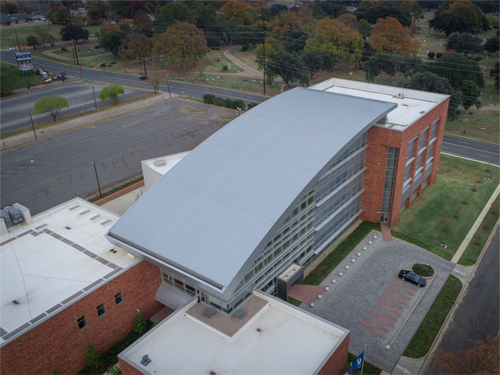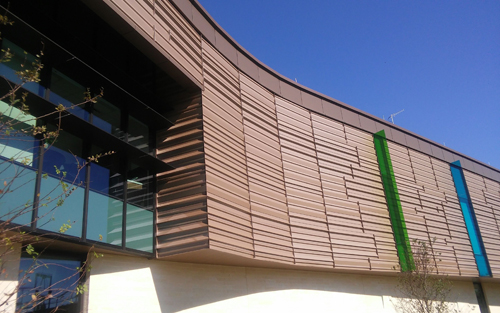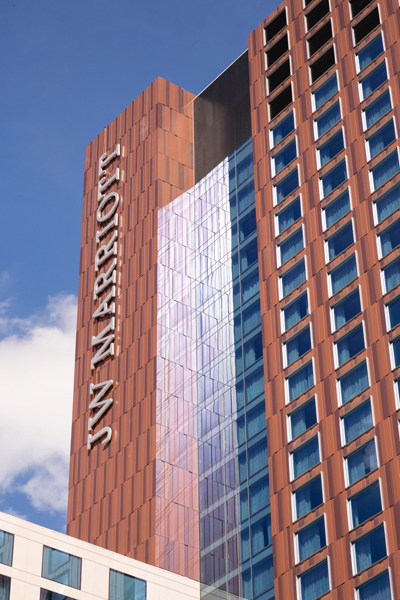 By Kathi Miller, McElroy Metal
By Kathi Miller, McElroy Metal
The paint used to coat metal roofing and siding panels has three basic components: pigment, which creates the color; solvent, which helps to dissolve the pigment; and binder or resin, which acts like the glue to hold everything together. Due to differences
in both pigment cost and the amount of pigment required, most metal panel manufacturers segment their PVDF offering into three pricing tiers.
 |
The North Louisiana Criminalistics Laboratory in Shreveport, LA is topped with McElroy Metal's Maxima panel profile with a Silver Metallic PVDF paint finish. |
Standard PVDF (Kynar 500/Hylar 5000) Colors
The first and lowest priced group is often referred to as the standard colors. These colors represent the bulk of the metal roof and wall panel industry. Given the basic laws of economics (the more you buy, the cheaper it is), most people expect this
color offering to be the least expensive. And they’re right. But what many folks don’t realize is that these colors require less pigment, so their lower cost is actually reflective of the fact that they are less expensive for paint manufacturers
to produce.
While most of the colors in these groups fall in the white, beige or earth tone family, dark bronzes and blacks are also commonly included.
 |
The New Recreation and Wellness Center at the University of Houston - Clear Lake is clad with custom fabricated metal panels fabricated from 22-gauge coil, supplied by McElroy Metal, with a Custom Aged Bronze PVDF paint finish. See more of this project
|
Premium PVDF (Kynar 500/Hylar 5000) Colors
While the Standard colors work for most projects, there are times where something a little more spectacular is desired for the color of a metal roof or wall system. Often, the decision stems from the desire to match a corporate brand or perhaps a designer
or owner wants all or part of a building to make a bigger statement. In those cases, Premium colors are often considered.
While there are many variables in the equation, a good rule of thumb is to allow 8-10 percent additional cost for colors in the Premium PVDF family. The additional cost stems from several factors.
First, the pigments used to produce these dramatic colors are more expensive than their standard color counterparts.
Secondly, Premium colors typically require more pigment (and less filler) than standard colors, which also makes them more expensive. As a side note, some of the colors in this family also carry a reduced paint warranty due to the performance of the pigments
used in this process. So, if the warranty length is important, always check with a reputable manufacturer during the color selection process.
It’s also important to note that the 8-10 percent upcharge for the premium colors “typically” applies only to panels and doesn’t apply to labor, trims and accessories. Consequently, the total cost increase to move from a Standard
to Premium color is often less than expected. As an example, for a 20,000 square foot standing seam roof, the cost difference to go from Standard to a Premium color might cost an additional $3,000-$5,000 total on the project. So, while it is a higher
price, the cost difference is pretty negligible, especially if it’s critical to the brand or building owner.
Colors in this family fall more into what you might call the exotics and include things like oranges, reds, vibrant blues and greens.

|
The metal facade of the JW marriott Hotel in Austin, TX is comprised of custom formed metal panels in three depths and five different widths. Three different colors of panels were utilized to mimic the appearance of weathered steel. The
18-gauge painted steel used to fabricate the panels was supplied by McElroy Metal. See more of this project
|
Metallic PVDF (Kynar 500/Hylar 5000) Colors
Moving the discussion onto metallics, it’s important to note that we’re referring to metallic “colors.” Metallic colors are completely different from an unpainted product like Galvalume or galvanized, which have an actual metallic
coating.
When comparing Standard, Premium and Metallic finishes, Metallic PVDF colors are the most expensive and normally carry a 10-12 percent cost increase over the standard PVDF colors.
Like Premium colors, some of the higher cost can be attributed to higher pigment cost. In some cases, the coating lines which apply the paint to the steel are also required to run at slower speeds for metallic paints, which can increase cost.
It’s also important to note that Metallic finishes can be directional, meaning they must be installed in the same direction to prevent perceived shade differences. Consequently, installers are required to take more care in the layout and installation
of materials, so installation costs are often higher for Metallic coatings than they are for either Standard or Premium colors. And, while it may not impact cost, metallic colors tend to be “batch sensitive,” meaning there may be slight
differences between paint produced at different times. Using products from several different batches on the same project can create aesthetic issues and should be avoided whenever possible.
Colors in this family tend to be coppers, silvers, bronzes and champagnes.
Summary
Keep in mind that the cost increase percentages outlines here are simply for budget purposes. If you have color or budget questions for an upcoming project or even want to chat more about the possibility of custom colors, contact us. We would love to
help.